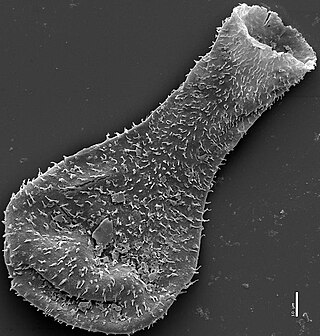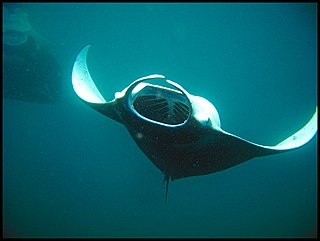Related Research Articles

Plankton are the diverse collection of organisms that drift in water but are unable to actively propel themselves against currents. The individual organisms constituting plankton are called plankters. In the ocean, they provide a crucial source of food to many small and large aquatic organisms, such as bivalves, fish, and baleen whales.

Clupeidae is a family of clupeiform ray-finned fishes, comprising, for instance, the herrings and sprats. Many members of the family have a body protected with shiny cycloid scales, a single dorsal fin, and a fusiform body for quick, evasive swimming and pursuit of prey composed of small planktonic animals. Due to their small size and position in the lower trophic level of many marine food webs, the levels of methylmercury they bioaccumulate are very low, reducing the risk of mercury poisoning when consumed.

Zooplankton are the animal component of the planktonic community, having to consume other organisms to thrive. Plankton are aquatic organisms that are unable to swim effectively against currents. Consequently, they drift or are carried along by currents in the ocean, or by currents in seas, lakes or rivers.

The Noctilucales are an order of marine dinoflagellates. They differ from most others in that the mature cell is diploid and its nucleus does not show a dinokaryotic organization. They show gametic meiosis.
Nekton or necton refers to aquatic organisms that can actively and persistently propel themselves through a water column. The term was proposed by German biologist Ernst Haeckel to differentiate between the active swimmers in a body of water, and the planktons that were passively carried along by the water current. As a guideline, nektonic organisms have a high Reynolds number and planktonic organisms a low one. However, some organisms can begin life as planktonic larvae and transition to nektonic juveniles and adults later on in life, sometimes making distinction difficult when attempting to classify certain plankton-to-nekton species as one or the other. For this reason, some biologists choose not to use this term.
In underwater diving, open water is unrestricted water such as a sea, lake, river, or flooded quarry. It is a contradistinction to confined water where initial skills training takes place. Open water also means the diver has direct vertical access to the surface of the water in contact with the Earth's atmosphere. Open water diving implies that if a problem arises, the diver can directly ascend vertically to the atmosphere to breathe air. Penetration diving—involving entering caves or wrecks, or diving under ice—is therefore not "open water diving". In some contexts the lack of a decompression obligation is considered a necessary condition for classification of a dive as an open water dive, as a decompression obligation is a procedural and safety restriction on immediate ascent to the surface, but this does not affect the classification of the venue as open water.

Chitinozoa are a group of flask-shaped, organic walled marine microfossils produced by an as yet unknown organism. Common from the Ordovician to Devonian periods, the millimetre-scale organisms are abundant in almost all types of marine sediment across the globe. This wide distribution, and their rapid pace of evolution, makes them valuable biostratigraphic markers.

Meroplankton are a wide variety of aquatic organisms which have both planktonic and benthic stages in their life cycles. Much of the meroplankton consists of larval stages of larger organism. Meroplankton can be contrasted with holoplankton, which are planktonic organisms that stay in the pelagic zone as plankton throughout their entire life cycle.
Tychoplankton are organisms, such as free-living or attached benthic organisms and other non-planktonic organisms, that are carried into the plankton through a disturbance of their benthic habitat, or by winds and currents. This can occur by direct turbulence or by disruption of the substrate and subsequent entrainment in the water column. Tychoplankton are, therefore, a primary subdivision for sorting planktonic organisms by duration of lifecycle spent in the plankton, as neither their entire lives nor particular reproductive portions are confined to planktonic existence.

A lake ecosystem or lacustrine ecosystem includes biotic (living) plants, animals and micro-organisms, as well as abiotic (non-living) physical and chemical interactions. Lake ecosystems are a prime example of lentic ecosystems, which include ponds, lakes and wetlands, and much of this article applies to lentic ecosystems in general. Lentic ecosystems can be compared with lotic ecosystems, which involve flowing terrestrial waters such as rivers and streams. Together, these two ecosystems are examples of freshwater ecosystems.
Biological oceanography is the study of how organisms affect and are affected by the physics, chemistry, and geology of the oceanographic system. Biological oceanography may also be referred to as ocean ecology, in which the root word of ecology is Oikos (oικoσ), meaning ‘house’ or ‘habitat’ in Greek. With that in mind, it is of no surprise then that the main focus of biological oceanography is on the microorganisms within the ocean; looking at how they are affected by their environment and how that affects larger marine creatures and their ecosystem. Biological oceanography is similar to marine biology, but is different because of the perspective used to study the ocean. Biological oceanography takes a bottom-up approach, while marine biology studies the ocean from a top-down perspective. Biological oceanography mainly focuses on the ecosystem of the ocean with an emphasis on plankton: their diversity ; their productivity and how that plays a role in the global carbon cycle; and their distribution.

In aquatic biology, the paradox of the plankton describes the situation in which a limited range of resources supports an unexpectedly wide range of plankton species, apparently flouting the competitive exclusion principle, which holds that when two species compete for the same resource, one will be driven to extinction.

Neuston, also called pleuston, are organisms that live at the surface of a body of water, such as an ocean, estuary, lake, river, or pond. Neuston can live on top of the water surface or may be attached to the underside of the water surface. They may also exist in the surface microlayer that forms between the top side and the underside. Neuston have been defined as "organisms living at the air/water interface of freshwater, estuarine, and marine habitats or referring to the biota on or directly below the water’s surface layer."

In physical oceanography, Langmuir circulation consists of a series of shallow, slow, counter-rotating vortices at the ocean's surface aligned with the wind. These circulations are developed when wind blows steadily over the sea surface. Irving Langmuir discovered this phenomenon after observing windrows of seaweed in the Sargasso Sea in 1927. Langmuir circulations circulate within the mixed layer; however, it is not yet so clear how strongly they can cause mixing at the base of the mixed layer.

Forage fish, also called prey fish or bait fish, are small pelagic fish that feed on plankton and other tiny organisms. They are preyed on by larger predators, including larger fish, seabirds and marine mammals. Typical ocean forage fish feed near the base of the food chain on plankton, often by filter feeding. They include particularly fishes of the order Clupeiformes, but also other small fish, including halfbeaks, silversides, smelt such as capelin and goldband fusiliers.

Due to the higher density of sea water than air, the force exerted by the same velocity on an organism is 827 times stronger in the ocean. When waves crash on the shore, the force exerted on littoral organisms can be equivalent to several tons.

Bacterioplankton refers to the bacterial component of the plankton that drifts in the water column. The name comes from the Ancient Greek word πλανκτος, meaning "wanderer" or "drifter", and bacterium, a Latin term coined in the 19th century by Christian Gottfried Ehrenberg. They are found in both seawater and freshwater.

Ichthyoplankton are the eggs and larvae of fish. They are mostly found in the sunlit zone of the water column, less than 200 metres deep, which is sometimes called the epipelagic or photic zone. Ichthyoplankton are planktonic, meaning they cannot swim effectively under their own power, but must drift with the ocean currents. Fish eggs cannot swim at all, and are unambiguously planktonic. Early stage larvae swim poorly, but later stage larvae swim better and cease to be planktonic as they grow into juveniles. Fish larvae are part of the zooplankton that eat smaller plankton, while fish eggs carry their own food supply. Both eggs and larvae are themselves eaten by larger animals.

Montipora digitata, also known as finger coral, is a species of stony coral. It is found in shallow water in East Africa, the Indo-West Pacific, Kenya, Mozambique and Rodriguez.

A planktivore is an aquatic organism that feeds on planktonic food, including zooplankton and phytoplankton. Planktivorous organisms encompass a range of some of the planet's smallest to largest multicellular animals in both the present day and in the past billion years; basking sharks and copepods are just two examples of giant and microscopic organisms that feed upon plankton.
References
- ↑ Sorokin, Yuri I. (12 March 2013). Coral Reef Ecology. Springer Science & Business Media. p. 96. ISBN 9783642800467.
